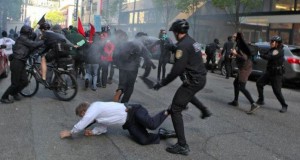The Seattle TV stations did a great job covering the May Day “protest.”
Seattle has always been blessed with great TV stations. I don’t think the people here know or understand that because their view of the relative strength of TV news operations between markets is limited – of course.
Only weirdos who watch three of four TV stations at once and poke around the web to watch what’s being done in other markets see how Seattle has traditionally stood out.
Uh, and for the record, I don’t know any such weirdos.
A couple interesting things come out of yesterday’s coverage – but I’m just going to hit one today – that being: The age old question involving the tree falling in the proverbial forest – that is – would the even even occur without the media?
Daniel Boorstin identified the concept of a “pseudo event” 50 years ago, and much of the May Day event certainly bears analysis under that paradigm.
I can always see the live shots and the standups that will wind up on the reporter’s reel – reporters make an effort to get a couple of those airchecked during any big disaster or event.
I don’t know anybody who would do such a thing.
From what I hear though, you get in front of the action – take your hand held mike – dodge around like a prize fighter – hope some big noise breaks up your standup so you can shudder and continue – and do a little running or falling.
But does it help or hurt the community and the enterprise of journalism?
When does “covering the news” turn into “making TV?”
This question has been debated by academics since the first tube glowed to produce a shadowy image on a screen.
But you can sure see it when it’s happening.
For news directors (KING, KIRO, KOMO, KCPQ) – do you want to be the first one punching out of wall-to-wall coverage to “rejoin our regularly scheduled program in progress?” Or, do you want to stay with it no matter what?
That too is a helluva’ tough call.
What do you think? Was there “too much” coverage? Did the media cover the event, or inspire it?









